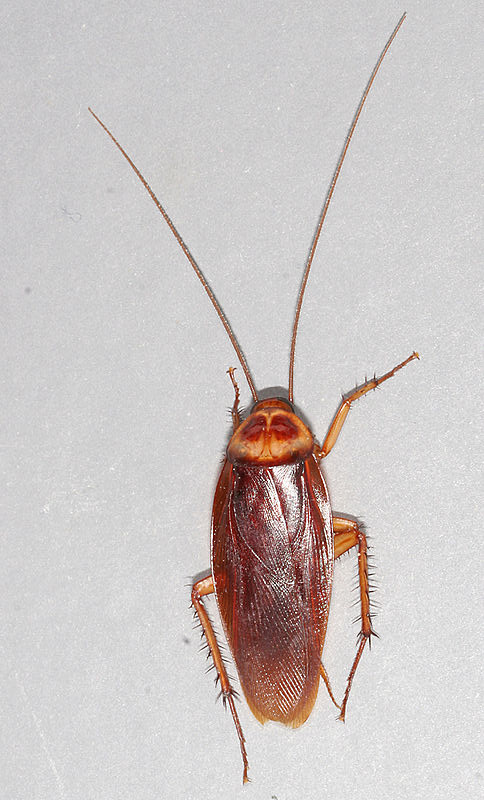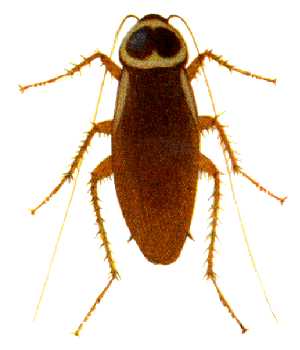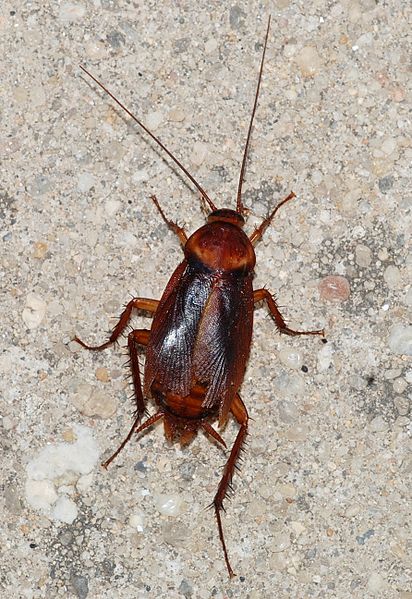Periplaneta americana (American Cockroach) (Linnaeus, 1758)
The Stereotypical Cockroach.
Table of Contents
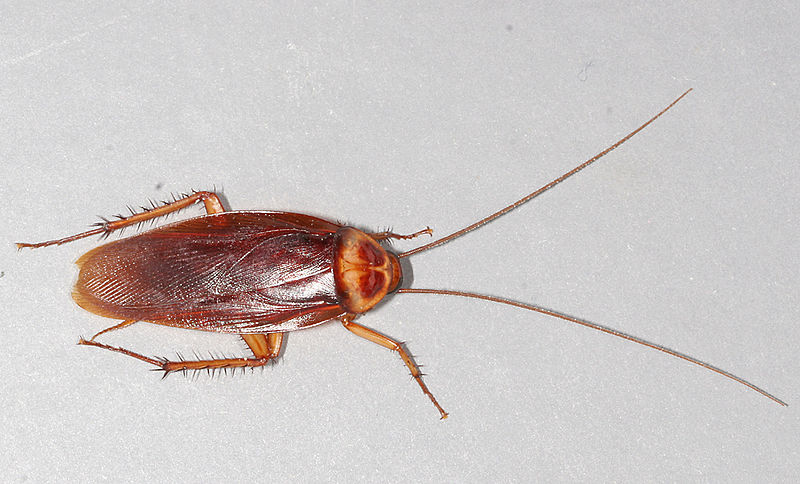 |
| The American cockroach Periplaneta americana: a very familiar sight in Singapore households, garbage piles, alleys, drains, sewers... Picture credited to Wiki user Gary Alpert. |
The American cockroach (Periplaneta americana) is the most common cockroach species that can be found both locally and globally. It is also the largest of the common urban cockroach species found in Singapore, which includes the Australian cockroach (Periplaneta australasiae), German cockroach (Blattella germanica) and Oriental cockroach (Blatta orientalis). Like other cockroaches that can be found in urban environment, the American cockroach is a notorious household pest, with pictures and images of these insects being commonly featured as icons in commercial pesticides.
Characteristics
Cockroaches are a wide and diverse group of insects that come in different shapes, sizes and colours. Some are capable of flight while others are not. Some are only found exclusivedly in forests while some, including the American cockroach, feels more at home in urbanized settings. An example of the diversity and variablility of cockroaches can be found in a comparison table of the four Singapore's urban cockroaches below.
Cockroaches can be characterized from other insect orders by the following features:
- Dorsoventrally-flattened oval body plan, giving them a "flat" appearance which allows them to squeeze through narrow gaps and cracks.
- Chewing mouthparts with mandibles.
- Well developed single pair of large compound eyes.
- Head held at an angle almost perpendicular to its body, with mouthparts facing backwards (opisthognathous).
- Large shield-like dorsal plate of thorax (pronotum) that may cover head.
- Enlarged, flat and transversed leg segmented joining to body (coxa).
- A pair of multi-segmented abdominal protrusions (cerci) present at the end of of the abdomen.
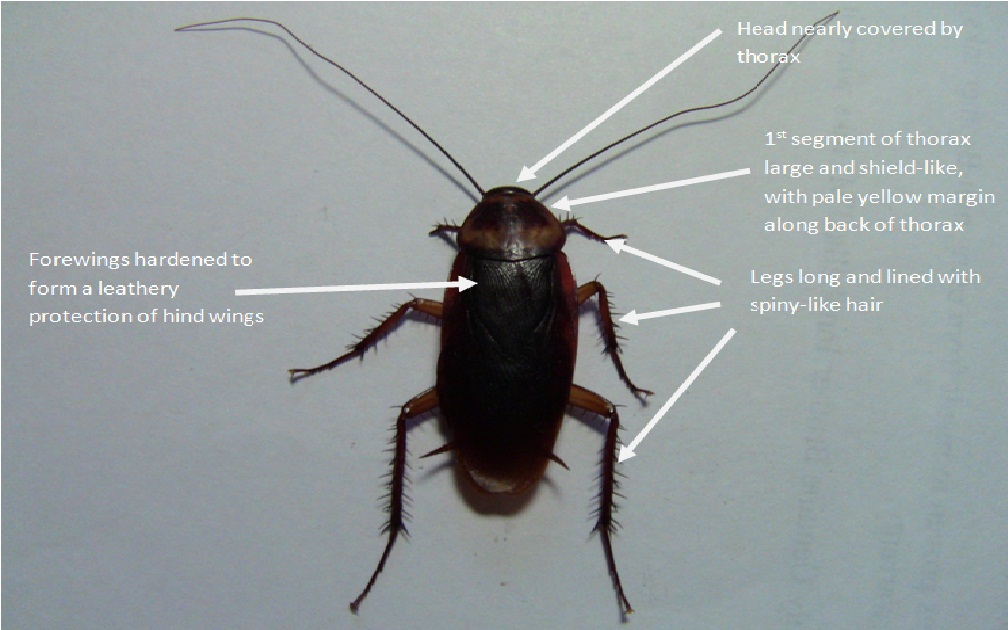 |
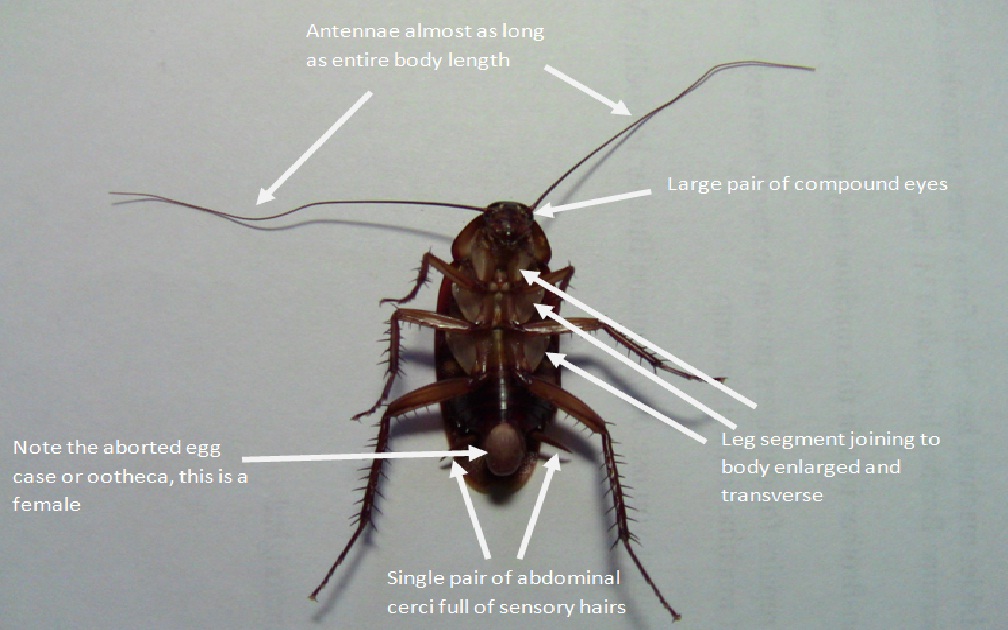 |
| Dorsal view (upside) of American cockroach. Photo taken by Tan Riyan. |
Ventral view (underside) of American cockroach. Photo taken by Tan Riyan. |
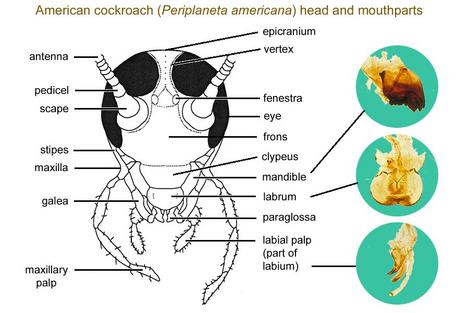 |
| The chewing mouthparts of the American cockroach. Picture drawn by Jack Scott of University of Alberta. |
Diagnosis
The American cockroach can be distinguished from other cockroaches through its following distinctive features:
- Large size, with adults capable of reaching an average of 40 mm in length from tip of head to abdomen.
- Reddish brown colouration with pale yellow margin along the edge of thorax.
- Forewings hardened to form a leathery protection (tegmina) over the delicate and more vulnerable hind wings, which are usually folded against the body when at rest.
- Long antennae that are almost as long as entire body length.
Comparisons of American cockroach with three other urban cockroaches of Singapore
| Name (Binomial name) |
American cockroach (Periplaneta americana) |
Australian cockroach (Periplaneta australasiae) |
German cockroach (Blattella germanica) |
Oriental cockroach (Blatta orientalis) |
||||||||
| Picture |
|
|
|
|
||||||||
| Distinguishing appearance |
Reddish brown colouration with pale yellow margin along thorax. |
Dark reddish brown colouration with bright yellow margin along thorax and yellow streaks at sides near wing base. |
Tan brown to almost black colouration with two dark parallel streaks running from head to base of the wings. |
Dark brown to black colouration. Females differ from males in that females have very short and useless (vestigial) wings. |
||||||||
| Size |
28 - 43 mm |
30 -35 mm |
12 -15 mm |
25 - 30 mm |
||||||||
| Preferred temperature |
32 °C (90 °F)Can tolerate cooler climate. |
32 °C (90 °F) |
32 °C (90 °F) |
20 °C (68 °F) to 29 °C (84 °F) |
||||||||
| Flight |
Yes |
Yes |
No |
No |
Etymology
The name "cockroach" derives from the Spanish word cucaracha, which was later transformed by English folk etymology into "cock" and "roach" Oxford dictionaries. "Blatta" is the latin word for cockroach.
Despite its name, the American cockroach does not originate from the Americas. It is believed to have originated from Africa, before being accidentally introduced into the United States as early as 1625 through ships as stowaways (Bell and Adiyodi, 1981).
Distribution
Due to global trade and commerce, the American cockroach has already spread across the entire world except for Antarctica.
Habitat
The American cockroach is mainly found thriving in urbanized habitats, both indoors and outdoors (Barbara, 2008). When indoors, they prefer dark sites with high humidity, such as sewers, tunnels, basements and around pipes and drains (Jones, 2008). They are also common in areas where food is readily available, such as restaurants, grocery stores, bakeries, markets and other places where food is prepared and stored (Barbara, 2008). Sometimes they can be found scurrying around inside houses, especially after heavy rain where cockroaches seek shelter inside houses (Barbara, 2008). In outdoors, the American cockroach can be found in moist shady areas such as undergrowth, yards, hollow trees, wood piles, under roof shingles, attics and garbage piles (Barbara, 2008).
Breeding
Egg
An adult female American cockroach lays its eggs in a brown, hardened purse-shaped egg case called an ootheca. About one week after mating, the female produces one ootheca, or even two at the peak of its reproductive period (Bell and Adiyodi, 1981). An average female can produce an ootheca about once a month for ten months, with 16 eggs per ootheca. Each time when the female lays an ootheca, it deposits it near a food source by either dropping it or gluing it to a surface with a secretion from its mouth (Barbara, 2008). A deposited ootheca contains sufficient water for the eggs to develop (Bell and Adiyodi, 1981).
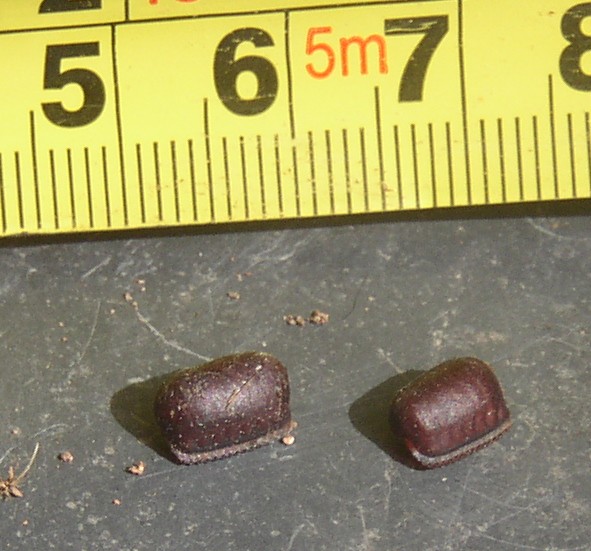 |
| American cockroach oothecae. Photograph credited to Fonkê Leif Selber und Carsten Selber. |
Nymphs
Like other cockroach species, the American cockroach adopts a hemimetabolic life cycle, meaning that the young cockroaches, or nymphs, partially resemble the adults and skip the pupal stages in their life cyles (Bell, 2007).
The nymphs of American cockroach hatch out from the eggs within 38 to 49 days (Jones, 2008). Nymphs are white in colour after immediate hatching, before turning to a grayish brown. Nymphs resemble adult cockroaches with the exception of the lack of wings. Nymphs molt regularly throughout their life cycles, growing in size after each molt. The number of molts required for nymphs to reach adulthood varies from 6 to 14 (Bell and Adiyodi, 1981). After each molt, nymphs appear white before becoming a uniform reddish brown (Barbara, 2008). Wing pads will begin to develop in the 3rd or 4th instar (Barbara, 2008).
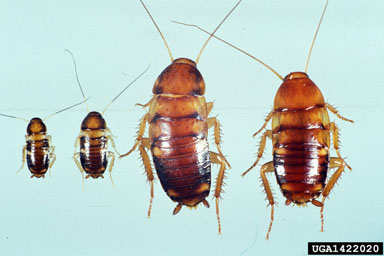 |
| American cockroach nymphs at various instar stages. Photograph credited to David R. Suiter, University of Georgia. |
Adults
The development of American cockroach from egg to adult takes an average of about 600 days (Barbara, 2008), in which the development time is greatly influenced by temperature (Jones, 2008). The male American cockroach differs from the female in that its cerci have 18 to 19 segments, while the female has 13 to 14 segments (Barbara, 2008). The male cockroach also has a pair of abdominal protrusions called styli in between its cerci, while the female lacks this pair of structures. American cockroaches can live 1 to 2 years in their adult life stage (Jones, 2008).
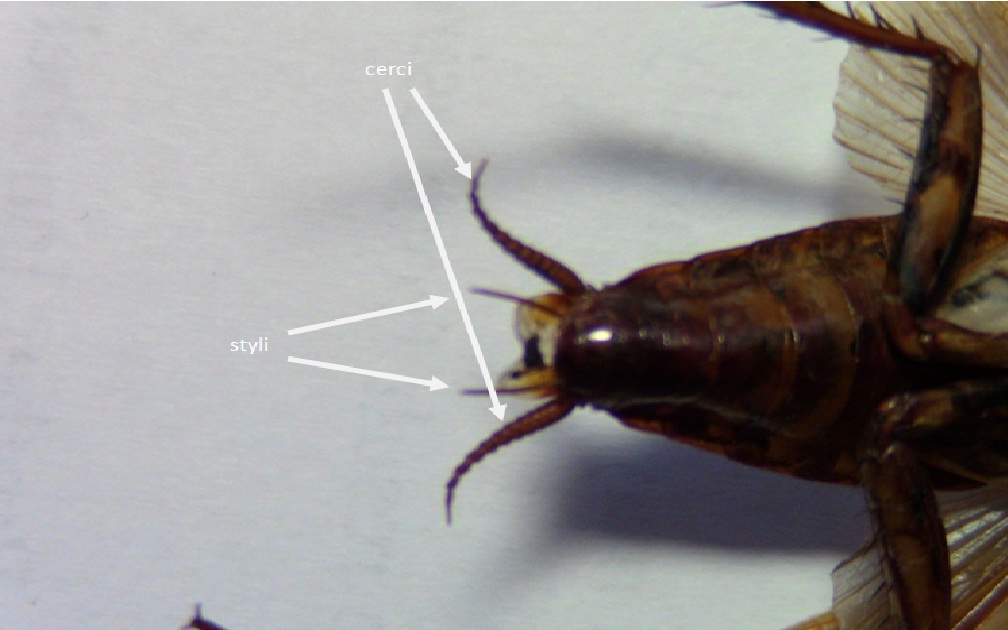 |
| Stylet pair between cerci of the adult male cockrach. Photo taken by Tan Riyan. |
Did you know?
It is true that cockroaches are capable of surviving nuclear radiation levels that would have killed adult humans in minutes. This is mainly due to the reason that nuclear radiation harms dividing cells the most and cockroaches have simple bodies and slower cell cycles. However, they are not the most radioactive resistanct insects, as experiments had shown that fruit flies and flour beetles can resist and survive even higher radiation levels than cockroaches.
If you are interested, you can read more in the following article:
http://dsc.discovery.com/tv-shows/mythbusters/mythbusters-database/cockroaches-survive-nuclear-explosion.htm.
Video credited to YouTube user gyurika2002.
Diet
The American cockroach is an opportunistic omnivore that can feed on almost anything. In the wild, they fulfill the role as scavengers, feeding on decaying organic matter. If opportunity arises, they will also feed on leftover food by humans, hence explaining their common occurence around garbage piles. There are observations of American cockroaches feeding on strange items such as sweets, paper, leather, hair, flakes of dried skin, dairy products, alcoholic drinks, cloth, soft part on the inside of animal hides and dead insects (Bell and Adiyodi, 1981). Cockroaches detect food primarily through their sense of smell with their long antennae, which are filled with olfactory receptors that can allow cockroaches to detect changes in odour concentrations across directions, allowing them to quickly home in towards the direction of food (Hinterwirth et al., 2004). Adult cockroaches have been known to be able to survive two to three months without feeding, while surviving up to one month without water (Jacobs, 2007).
Did you know?
Cockroaches can survive decapitation and still capable of living for weeks, before dying of starvation or thirst. This is mainly due to the many differences in the morphological desgins in circulatory, respiratory and nervous system between humans and cockroaches.
If you are interested, you can read more in the following article:
http://www.scientificamerican.com/article.cfm?id=fact-or-fiction-cockroach-can-live-without-head
Natural Enemies - Predators and Parasites
The oothecae of the American cockroach have known to be hosts to some parasitoid wasp species, especially those of the Evanidae family (Ng et al., 2011). Nymphs are commonly preyed upon by many insectivorous animals, such as birds, geckos, ants, and spiders. The large size and foul odour of adult cockroaches can deter most insectivorous animals (Bell and Adiyodi, 1981), although sometimes they have been observed to fall prey to large centipedes, tarantulas, praying mantids, kingfishers, crows and small mammals.
Large mantis in Israel feeding on an American cockroach. Warning: video content can be extremely graphic to some people. Viewer discretion is advised.Video credited to YouTube user Reptiliatus.
Defence
The main defence of the American cockroach against its would be predators is its speed. The American cockroach has been considered as one of the fastest running insects in the world despite its large size (Merritt, 1999). It was known in an experiment conducted by University of California, Berkeley in 1991, that an American cockroach registered a record speed of 5.4 km/h (3.4 mph), about 50 body lengths per second; comparable to a human running at 330 km/h (210 mph) (Shukolyukov, 2001).
The American cockroach mainly detects its surroundings for danger through sensory hairs in the abdominal cerci, which are highly sensitive to motion through changes in the air current(Stern et al., 1997). The nerves or neurons that innervated the cockroaches' cerci are specifically synapsed with a set of giant interneurons (GIs) in the terminal ganglion, so that a trigger from cerci-innervated neurons will trigger an involuntary response for an immediate escape run (Stern et al., 1997). This set of escape sensorimotor pathway would also seem to mature as the cockroach approaches adulthood, becoming even more highly responsive after the molt to adult (Libersat et al., 2005).
Besides its unique escape sensorimotor pathway, the American cockroach has also be shown to have a unique behavioural strategy of escaping predators by either running away or towards the threat, forcing predators to keep guessing the cockroach's preferred escape trajectories (Domenici et al., 2009). Research has shown that the American cockroach prefers to choose escape trajectories "away" from threats, unless the "towards" escape trajectory angle requires a body turn angle of less than 30 degrees, indicating that the cockroach will choose to run towards the threat when it wants to minimize its turn so that it can reach an escape trajectory in a relatively short amount of time (Domenici et al., 2009)
Interaction with People
The American cockroach is a commonly known household pest. It produces odorous secretions that can alter the flavor of food. With higher concentration of cockroaches, the strong the concentration of this odorous secretion (Jacobs, 2007). Due to their preference in dark moist areas, leading to coming in contact with unhygienic environments such as sewers and garbage piles, the American cockroaches can pick up disease-causing (pathogenic) bacteria like Salmonella spp. on their legs and later deposit them on foods and cause food poisoning (Paul et al., 1992). Other bacteria that an American cockroach may carry include Enterobacter cloacae, Klebsiella pneumoniae and Klebsiella oxytoca, making the American cockroach a serious health hazards to hopsital patients (Rivault et al., 1993). House dust containing cockroach feces and body parts can also trigger allergic reactions such as skin rashes, watery eyes, congestion of naval passages, sneezing and asthma (Jacobs, 2007) in certain individuals (New York City Environmental Health Sciences).
An example of cockroach exodus after fogging.Video credited to YouTube user ii53.
Did you know?
Katsaridaphobia is the abnormal and persistent fear of cockroaches.
If you are interested, you can read more in the following article:
http://www.fearofstuff.com/insects/the-fear-of-cockroaches/
Did you know?
Cockroaches may have been known to transmit pathogens such as Salmonella bacteria, they are not specific vectors for any pathogens. The diseases transmitted by cockroaches are usually the result of pathogens being picked up by a cockroach's legs as it runs through an unhygienic area. This is unlike the case of Aedes mosquito being a vector for Dengue fever and West Nile Virus. So next time if you want to conduct pest control measures in your home, you should consider more about keeping mosquitos out of your home than cockroaches.
Control
The most common method of control against the American cockroach is through insecticides. Many classes of commercial insecticides, including botanicals, inorganics, insect growth regulators and pyrethroids have been proven to be effective in killing and controlling American cockroach populations (Jones, 2008). These insecticides may come in the form of aerosols, baits, and dusts (Jacobs, 2007), in which different forms of insecticides can be applied according to practical use (Jones, 2008).
| Insecticide Type |
Method of Application |
Advantages |
Disadvantages |
| Aerosol |
|
|
|
| Bait |
|
|
|
| Dust |
|
|
|
Note that all insecticides are poisonous, and instruction labels must be read for each insecticides before using them! Do not apply any of these insecticides on your food or near food preparations/storage areas!
As mentioned earlier, there are a number of predators and parasitoids that prey upon the American cockroach. Out of many of these natural enemies, parasitoid wasps are one of the most effective biological control agents against insect pests, including cockroaches, due to their specificity to their target hosts which mean that they will only target a few specific kinds of insects as hosts and will leave other insects such as the more beneficial ones alone (Ng et al., 2011). In Singapore, one noticeable parasitoid wasp, Evania appendigaster, can be commonly found in both natural and urbanized settings. This wasp species lays its eggs specifically in oothecae of cockroaches, including those of the American cockroaches'. The adult female Evania drills a hole through the ootheca and deposits its eggs via an ovipositor. The larva of the Evania wasp feeds on the cockroach's eggs still inside the ootheca, molts and pupates inside the ootheca before emerging out of the empty egg case as an adult (Stange, 1978).
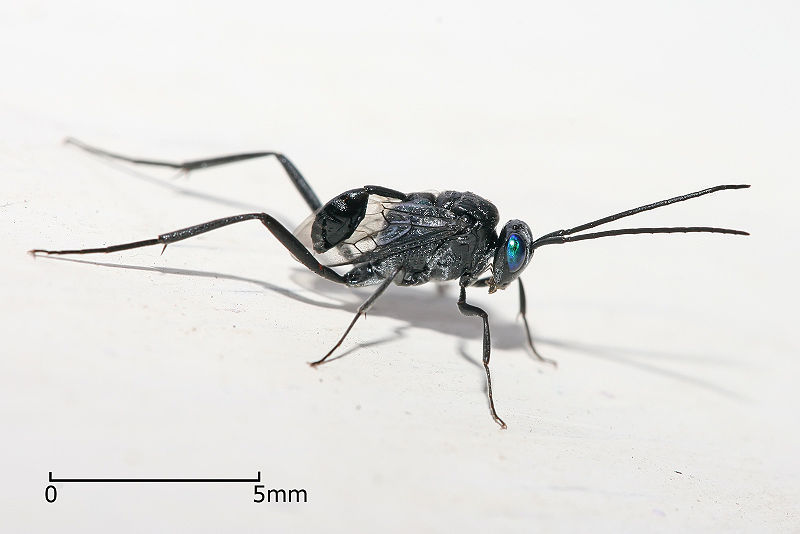 |
|
| Evania appendigaster: one of the few biological control agents against American cockroach that can be found in Singapore. Picture credited to Wiki user Muhammad Mahdi Karim. |
Evania appendigaster: a parasitoid wasp known to lay its eggs in cockroaches' oothecae. Larvae of this wasp feeds on the eggs and develops inside the oothecae, before emerging out as an adult. Video embed from YouTube.com uploaded by imagoUFRJ. Video has been licensed by [Creative Commons Attribution license] (reuse allowed). |
What You can Do?
While application of insecticides are useful to control cockroach populations when INFESTATIONS HAVE ALREADY OCCURED, proper sanitation practice is another method to control cockroach populations BEFORE AN INFESTATION CAN BEGIN. To prevent cockroaches from entering and infesting your own houses, keep your house clean both indoors and outdoors so that you will not unintentionally create a suitable habitat for cockroaches to find food, shelter and breeding site. Here are some measures you can do to keep cockroaches out of your home.
- Dispose your garbage regularly
- Cover up your trash bin or refuse chute
- Do not leave food lying around
- Do not leave soda cans, beer bottles, food containers, paper bags, cardboxes, cardboards and unwanted furnitures around
- Store food properly in airtight containiers
- Maintain a regular cleaning schedule especially in bathrooms and kitchens
- Tape up potential points of entry such as cracks and crevices in walls and around pipes under kitchen or bathroom sinks
- If there is a water leak in the house, repair it quickly so as to avoid creating a moist environment suitable for a cockroach to live in
If you have started to find cockroaches scurrying around in your home, apply appropriate insectides to control the cockroach population around your home before populations can explode. Here are some ways you can do.
- Immediately spray aerosol insecticide on any cockroach you can find, nymphs or adults
- Place cockroach baits near suspected cockroach point of entry, such as narrow cracks and crevices in walls and around pipes under kitchen or bathroom sinks
- Spray aerosol insecticide into potential cockroach hiding spots, especially narrow cracks and crevices and behind or under beds, furniture and refrigerators
- Apply a thin layer of insecticidal dusts near suspected cockroach point of entry
Remember: all insecticides are poisonous, and instruction labels must be read for each insecticides before using them! Do not apply any of these insecticides on your food or near food preparation/storage areas!
Taxonomy
| Kingdom |
Annimalia |
- Animal |
| Phylum |
Arthropoda |
- Arthropod |
| Subphylum |
Hexapoda |
- Hexapod (6 - legs) |
| Class |
Insecta |
- Insects |
| Subclass |
Pterygota |
- Winged insects |
| Infraclass |
Neoptera |
- Modern folding-wing insects |
| Order |
Dicytoptera |
|
| Suborder |
Blattaria |
- Blattodea (cockroaches) |
| Superfamily |
Blattoidea |
|
| Family |
Blattidae |
|
| Subfamily |
Blattinae |
|
| Genus |
Periplaneta |
|
| Species |
americana |
- American cockroach (Linnaeus, 1758) |
http://www.itis.gov/servlet/SingleRpt/SingleRpt?search_topic=TSN&search_value=102406
The study of taxonomy is crucial for the understanding of biology in general. By organizing and classifying living creatures, including the American cockroach, biologists are able to determine the evolutionary relationship between species, as well as identifying and monitoring biodiversity so that species and biodiversity conservation can be planned accordingly.
Phylogeny
The phylogeny tree of the suborder Blattaria is still highly debated among the experts, in which the relationships among some cockroach families and subfamilies are still very much debated. This is especially for the case of the genus Crytocercus, which position in the Blattaria phylogeny tree is still very controversial (Tree of Life web project).
The American cockroach belongs to the family Blattidae, which is considered to be a more derived taxa in the Blattoidea superfamily, and a sister taxa to the termites (Eggleton et al, 2007). Recent genetic studies through genetic sequencing of mitochondrial DNA, cytochrome oxidase II (COII) DNA and histone 3 DNA had revealed that termites should be considered as an epifamily under Blattaria, confirming them as eusocial cockroaches (Eggleton et al., 2007).
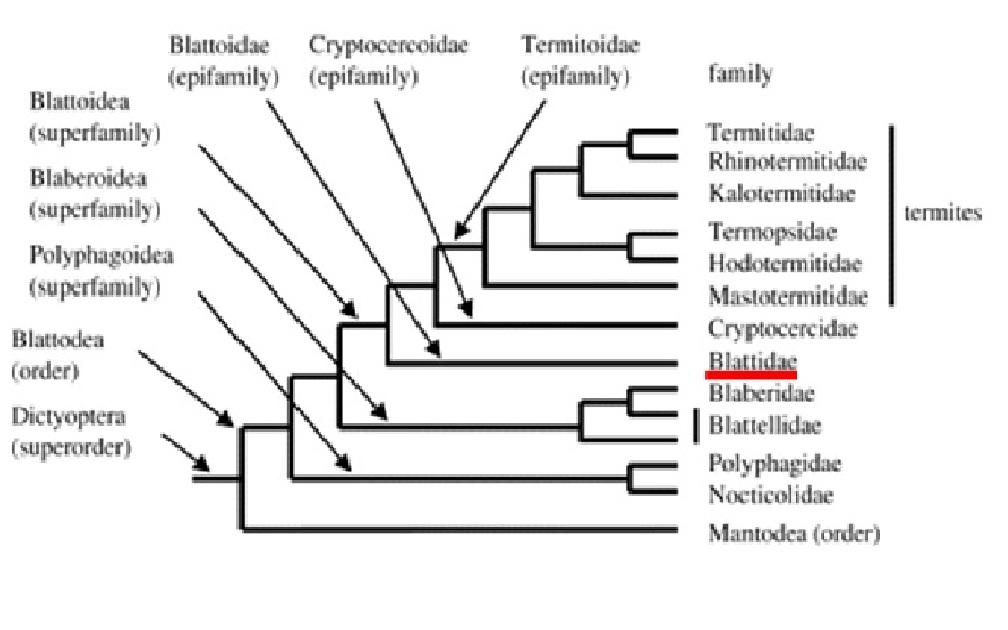 |
| Dicytoptera phylogenetic tree as proposed by Eggleton et al. (2007). Note the postion of the family Blattodae (highlighted by red line) where the American cockroach belongs to. Notice that the Blattidae is a sister taxa to the termites. |
Recently, the complete mitochondral genomes of the American cockroach and German cockroach had been sequenced (Xiao et al., 2012). From the results of their mitochondrial genome sequencing, it was confirmed that both the American and German cockroaches shared the same mitochondrial genome organization. It was also confirmed that the termites should be treated as a superfamily or epifamily under the cockroaches.
Evolution History
The first cockroach-like ancestors (Blattoptera) were believed to have appeared back all the way to the Carboniferous Period between 354 to 295 million years ago. Its form evolved directly from the segmented form and simple anatomy of the onychophoran, a very functional and successful pattern. Cockroaches are thought to have emerged on Pangaea, the original super-continent, or on Gondwanaland, the daughter continent of Pangaea. The cockroach had adapted and evolved over millions of years to be able to survive the major extinctions that many species succumbed to (Copeland, 2003).
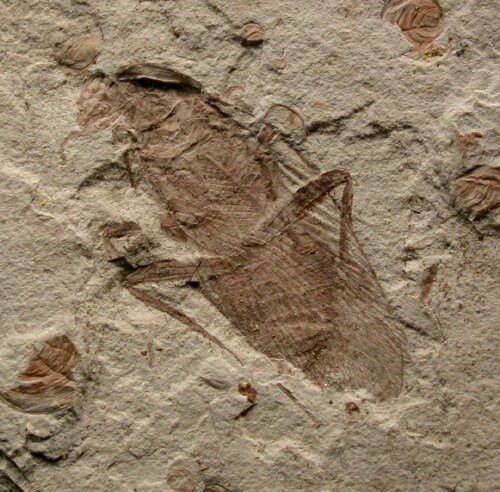 |
| A cockroach fossil dating back to lower Cretaceous (~125 million years ago). Note that it looks so similar to cockroaches that you still see today everywhere! Photo credited to Virtual Fossil Museum. |
Other links to American cockroach and its related kins
- BugGuide.net - Order Blattodea - Cockroaches and Termites: http://bugguide.net/node/view/342386
- Encylopedia of Life - Periplaneta americanahttp://eol.org/pages/1076920/overview
- ITIS Report - Periplaneta americana:http://www.itis.gov/servlet/SingleRpt/SingleRpt?search_topic=TSN&search_value=102406
- Tree of Life web project - Blattidae: http://tolweb.org/Blattidae
- Wikipedia.org - American cockroach: http://en.wikipedia.org/wiki/American_cockroach
- Wikipedia.org - Cockroach: http://en.wikipedia.org/wiki/Cockroach
References
- Barbara, K. A. (2008). American cockroach - Periplaneta americana (Linnaeus). Retrieved 3 November 2012: http://entomology.ifas.ufl.edu/creatures/urban/roaches/american_cockroach.htm
- Bell, W. (2007). Cockroaches. Baltimore: The Johns Hopkins University Press.
- Bell, W. J. and Adiyodi, K. G. (1981). The American Cockroach. London: Chapman and Hall.
- Choi, C. (2007). Fact or Fiction?: A Cockroach can Live Without its Head. Retrieved 17 November 2012, from Scientific American: http://www.scientificamerican.com/article.cfm?id=fact-or-fiction-cockroach-can-live-without-head.
- Copeland, M. (2003). Cockroach. London: Reaktion Books LTD.
- Could Roaches Really Survive a Nuclear Explosion? Retrieved 17 November 2012, from Mythbusters Database: http://dsc.discovery.com/tv-shows/mythbusters/mythbusters-database/cockroaches-survive-nuclear-explosion.htm.
- Gibb, T. J. and Oseto, C. Y. (2006). Arthropod Collection and Identification - Laboratory and Field Techniques. United States: Academic Press.
- Grimaldi, D. (1997). A fossil mantis (Insecta: Mantoidea) in Cretaceous amber of New Jersey, with comments on early history of Dictyoptera. American Museum Novitates 3204, 1–11.
- Domenici, P., Booth, D., Blagburn, J. M. and Bacon, J. P. (2009). Escaping away from and towards a threat: the cockroach's stategy for staying alive. Communicative and Integrative Biology, 2(6), 497-500.
- Eggleton, P., Beccaloni, G. and Inward, D. (2007). Response to Lo et al. Biology Letters, 3 (5), 564-565.
- Hinterwirth, A., Zeiner, R. and Tichy, H. (2004). Olfactory receptor cells on the cockroach antennae: responses to the direction and rate of change in food odour concentration. European Journal of Neuroscience, 19(12), 3389-3392.
- Jacobs, S. (2007). American Cockroaches. The Pennsylvania State University. Retrieved 3 November 2012: http://ento.psu.edu/extension/factsheets/american-cockroaches.
- Jones, S. C. (2008). Agricultural and Natural Resources Fact Sheet: American Cockroach (HYG-2096-08). Retrieved 4 November 2012, from Ohio State University: http://ohioline.osu.edu/hyg-fact/2000/pdf/2096.pdf.
- Libersat, F., Leung, V., Mizrahi, A., Mathenia, N. and Comer, C. (2005). Maturation of escape circuit function during the early adulthood of cockroaches Periplaneta americana. Journal of Neurobiology, 62(1), 62-71.
- Merritt, T. M. (1999). Chapter 39 — Fastest Runner. Book of Insect Records. University of Florida website: http://entomology.ifas.ufl.edu/walker/ufbir/chapters/chapter_39.shtml.
- New York City Environmental Health Services. Retrieved 3 November 2012: http://www.nyc.gov/html/doh/html/ehs/ehscroach.shtml.
- Ng, P. K. L., Corlett, R. T. and Tan, H. T. W. (Eds.) (2011). Singapore Biodiversity: An Encyclopedia of the Natural Environment and Sustainable Development. Singapore: Editions Didier Millet.
- Paul, S., Khan, A. M., Bagui, M. A., and Muhibullah, M. (1992). Evaluation of the common cockroach Periplaneta americana (L.) as carrier of medically important bacteria. Journal of Communicable Diseases, 24 (4), 206-210. Retrieved 3 November 2012, from Pubmed.gov: http://www.ncbi.nlm.nih.gov/sites/entrez?cmd=Retrieve&db=PubMed&list_uids=1344954&dopt=Abstract.
- Rivault, C., Cloarec, A. and Le Guyader, A. (1993). Bacterial load of cockroaches in relation to urban environment. Epidemiology and Infection, 110 (2), 317-325. Retrieved 14 November 2012, from PubMed.gov: http://www.ncbi.nlm.nih.gov/pmc/articles/PMC2272268/
- Schal, C. and Hamilton, R. L. (1990). Integrated suppression of synanthropic cockroaches. Annual Reviews Entomology, 35, 521–551.
- Shukolyukov, S.A. (2001). Discovering the Achievements of the American Cockroach. University Science News. Retrieved 3 November 2012: http://www.unisci.com/stories/20013/0927016.htm.
- Stange, L. A. (1978). Evania appendigaster (Linnaeus), a Cockroach Egg Parasitoid (Hymenoptera: Evaniidae). Florida Department of Plant Industry Entomology Circular, 191. Retrieved 14 November 2012, from:http://www.freshfromflorida.com/pi/enpp/ento/entcirc/ent191.pdf.
- Stern, M., Ediger, V. L., Gibbon, C. R., Blagburn, J. M. and Bacon, J. P. (1997). Regeneration of cercal filiform hair sensory neurons in the first-instar cockroach restores escape behaviour. Journal of Neurobiology, 33(4), 439-458.
- Xiao, B., Chen, A. H., Zhang, Y. Y., Jiang, G. F., Hu, C. C. and Zhu, C. D. (2012). Complete mitochondrial genomes of two cockroaches, Blatella germanica and Periplaneta americana, and the phylogenetic position of termites. Current Genetics, 58 (2), 65-77.
| Subject | Author | Replies | Views | Last Message |
|---|---|---|---|---|
| No Comments | ||||
For any further reviews or questions about this species page, please email to the following address:
Tan Riyan (National University of Singapore): riyan3589@gmail.com
